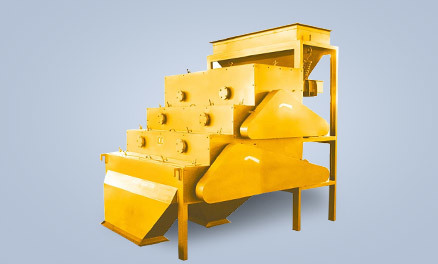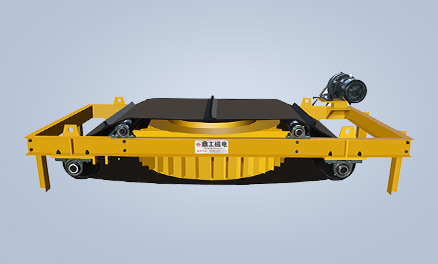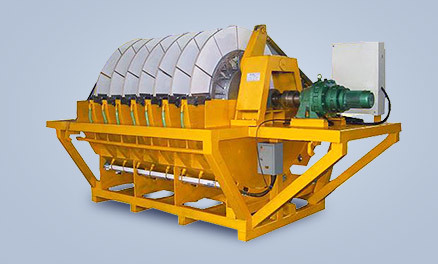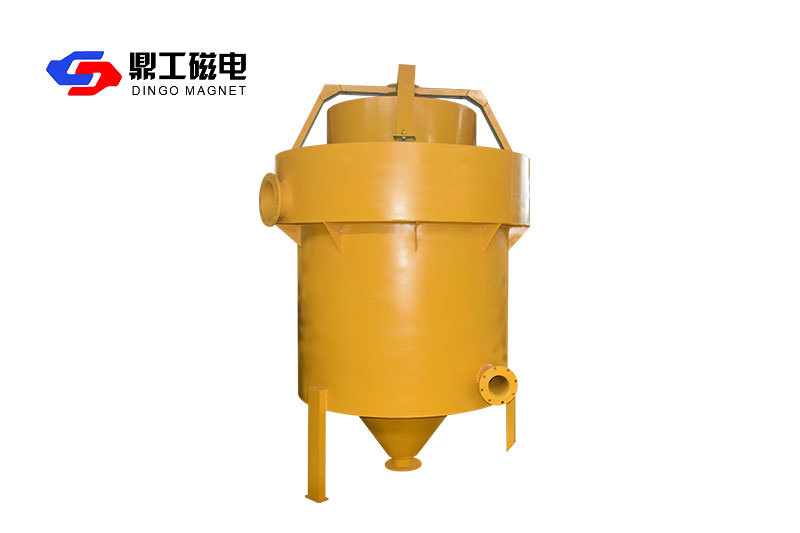PRODUCTS
CS series magnetic sludge removal tank
Category:
Keywords:
Tel:
Email:
CS series magnetic sludge removal tank
The CS series magnetic sludge removal tank is a magnetic separation equipment that separates magnetic and non magnetic ore particles (slime) under the action of gravity, magnetic force, and upward water flow force. It is mainly used for selection in industries such as mineral processing.
This product adopts computer optimized design, with high working efficiency, good reliability, reasonable structure, simple operation, and is an ideal equipment for ore mud separation.
The current magnetic dewatering tanks are divided into two types based on magnetic sources: permanent magnetic dewatering tanks and electromagnetic dewatering tanks. The most widely used one is the permanent magnet dewatering tank. It is composed of a trough body, a tower shaped magnetic system, a feeding tube (or ore closing ring), a rising water pipe, and a drainage device (including an adjusting handwheel, lead screw, and drainage rubber mound). The inverted flat bottomed conical groove is made of 6mm ordinary steel plate. In order to facilitate the smooth discharge of magnetic products from the bottom of the groove, there should be a cone angle at the bottom of the groove, usually 50 °~60 °. At this time, the ratio of groove diameter to depth is 1.4~1.5. The tank body can be roughly divided into three areas along the axis, namely the overflow (tailings) area, the selection zone, and the selection zone. The overflow area is close to the overflow surface, with a magnetic sludge removal tank, with a depth of approximately 150-300mm. The selection zone is located near the ore feeding port, and the concentrate area is near the lower part of the tank.
The ore feeding tube is made of hard plastic sheets made of non-magnetic materials and supported on the upper part of the tank by an aluminum bracket made of non-magnetic materials, with a diameter slightly smaller than the diameter of the magnetic system. The outlet of the ore feeding tube should be located at an appropriate position above the magnetic system, such as if the top of the magnetic system is too far away. Due to the weak magnetic field and the tendency to flip, the loss of magnetic ore particles in the overflow will increase; If it is too close, the magnetic field here is too strong, and the magnetic product will be mixed with more gangue, which will reduce the concentrate grade and even cause blockage of the ore feeding.
The tower shaped magnetic system is composed of many ferrite permanent magnet blocks stacked together, placed on a magnetic guide plate, and fixed to the middle and lower parts of the groove through a bracket. The position of the tower shaped magnetic system in the slot has a direct impact on the selection index. The magnetic system position is too high, the selection of zones is too close to the overflow surface of the tank, the water consumption of the magnetic sludge removal tank, and the tailings grade is high; The position is too low, and due to the strong magnetic field at the bottom of the slot and the small gap between the magnetic system and the slot bottom, it is easy to block the ore discharge port, causing difficulties in ore discharge. The distance between the bottom of the magnetic system and the bottom of the groove is related to the specifications of the magnetic dewatering tank.
Technical characteristics
Advantages: It has the advantages of simple structure, no running parts, convenient maintenance, simple operation, and large processing capacity.
Disadvantage: Coarse grained gangue cannot be removed.
It is generally used for separating fine magnetite ore and concentrating magnetite concentrate before filtration.
Working principle
Gravity causes the mineral particles to sink, and the magnetic force is perpendicular to the isomagnetic induction line and points towards the area with high magnetic induction intensity. Its function is to accelerate the sinking of magnetic particles and attract them to the surface of the magnetic system. The upward flow force prevents the settlement of non magnetic fine-grained gangue and ore mud, causing them to separate from the magnetic ore particles as the upward flow enters the overflow. The rising water flow can also make the magnetic ore particles loose, washing out the mixed gangue and improving the grade of the magnetic concentrate. The appearance of the magnetic dewatering tank is very similar to that of the conical unit, but the difference is that a magnetic system is added to the conical box.
The ore slurry is fed into the conical bucket, passes through the conical bucket, passes through the conical iron core 2, and merges with the clean water flowing into the water baffle plate 3 to form a countercurrent. At this time, the magnetic field generated by the coil passes through the outer barrel body 4 and the lower end of the conical iron core 2, creating a strong magnetic field at the bottom of the conical bucket. The reverse rising ore slurry falling from the conical bucket is attracted by magnetic force, causing finer magnetic ore particles to aggregate into large and heavy particles and settle at the bottom by gravity, And naturally discharged from the ore discharge port 5, the Weifang magnetic sludge removal tank, and the light and small weakly magnetic particles are discharged from the upper part of the barrel body to the overflow tank through the action of upward water flow, becoming tailings.
Product installation and use
Magnetic dewatering tanks can replace magnetic separation operations based on their purpose and performance, and can also be configured to improve separation efficiency in other equipment.
The axis of the magnetic dewatering tank should be vertical and fixed on the bracket. There should be no possibility of vibration during work, and its installation position should take into account the convenience of sand feeding, ore discharge, adjustment, and other operations. The CS series magnetic mud removal tank should have no sharp corners at the bending of all connecting rubber pipes to avoid affecting the flow of mineral slurry. Attention should be paid to tightening the connection and there should be no leakage. The magnetic dewatering tank should be installed at a location with a single-phase AC 50HZ, 220V power supply, and equipment such as a self supplied water tank. When the excitation current of the magnetic dewatering tank is 1. * *, the use time is only 2 hours, and the coil heating should not exceed 90 ℃. If overheating is found during operation, the operation should be stopped and the temperature should be reduced before use. The water flow adjustment should be based on the overflow and settlement selection, and the water pressure and the distance between the water flow baffle 3 should be adjusted.
Product parameters
| Model | Cylinder diameter mm | Outlet diameter mm | Slurry processing capacity t/h | Weight kg |
| CS-10 | 1000 | 300 | 15-30 | 1050 |
| CS-15 | 1500 | 350 | 20-45 | 1400 |
| CS-20 | 2000 | 370 | 25-55 | 1850 |
| CS-25 | 2500 | 400 | 30-65 | 2300 |
| CS-30 | 3000 | 450 | 35-75 | 2860 |
| CS-35 | 3500 | 500 | 40-85 | 3470 |
Related Products







